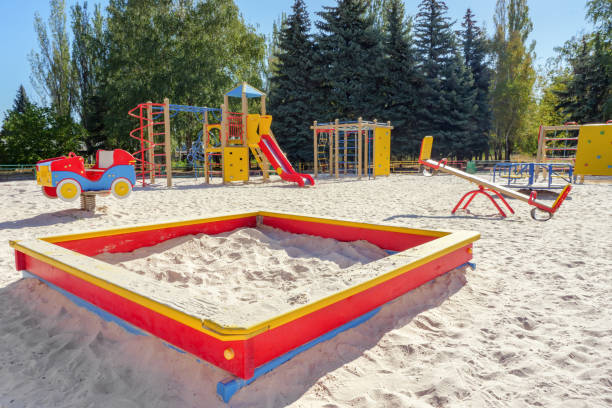Learn About Playground Equipment, Its Costs, and How It Balances Safety and Engagement
Playground equipment forms the foundation of childhood recreational spaces, offering children opportunities for physical activity, social interaction, and cognitive development. From traditional swings and slides to modern climbing structures and sensory panels, these carefully designed elements work together to create environments where children can explore, learn, and grow while having fun in safe, engaging settings.

Playground equipment has evolved significantly from simple metal structures to sophisticated play systems designed with child development and safety as primary considerations. Modern playgrounds feature equipment made from durable materials like high-density polyethylene, powder-coated steel, and engineered wood that can withstand various weather conditions while providing years of safe play experiences.
Introduction to Playground Equipment
Contemporary playground equipment encompasses a wide range of structures designed for different age groups and developmental stages. Traditional components include swings, slides, climbing frames, and see-saws, while modern additions feature interactive panels, sensory play elements, and inclusive designs that accommodate children with disabilities. Equipment manufacturers now focus on creating modular systems that can be customized to fit specific space requirements and budget constraints.
Age-appropriate zoning has become a standard practice, with separate areas designated for toddlers (2-5 years) and school-age children (5-12 years). This approach ensures that equipment challenges are suitable for different developmental stages while maintaining safety standards across all play areas.
Playground Equipment Costs
The financial investment in playground equipment varies significantly based on size, complexity, materials, and installation requirements. Basic residential swing sets typically range from $200 to $2,000, while comprehensive commercial playground systems can cost between $15,000 and $100,000 or more.
Factors influencing costs include site preparation requirements, safety surfacing materials, accessibility compliance, and ongoing maintenance needs. Professional installation adds approximately 20-30% to equipment costs, while safety surfacing materials like rubber mulch or poured-in-place rubber can add $3-15 per square foot to the total investment.
| Equipment Type | Provider | Cost Estimation |
|---|---|---|
| Residential Swing Set | Lifetime Products | $800 - $2,500 |
| Commercial Playground System | GameTime | $25,000 - $75,000 |
| Modular Play Structure | Landscape Structures | $15,000 - $50,000 |
| Inclusive Playground Equipment | Kompan | $30,000 - $80,000 |
| Safety Surfacing Installation | PlaySafe Surfacing | $5 - $12 per sq ft |
Prices, rates, or cost estimates mentioned in this article are based on the latest available information but may change over time. Independent research is advised before making financial decisions.
How Playground Equipment Balances Safety and Engagement
Modern playground design prioritizes creating engaging experiences while maintaining rigorous safety standards. Equipment manufacturers follow guidelines established by the Consumer Product Safety Commission and ASTM International to ensure structures meet specific safety criteria for fall heights, spacing requirements, and material specifications.
Engaging elements like climbing walls, tunnel systems, and interactive panels challenge children physically and cognitively while incorporating safety features such as appropriate handholds, non-slip surfaces, and adequate fall zones. The balance between challenge and safety is achieved through careful design that provides age-appropriate risk-taking opportunities within controlled environments.
Safety surfacing plays a crucial role in this balance, with materials engineered to provide adequate impact attenuation while maintaining accessibility and durability. Regular safety inspections and maintenance protocols ensure equipment continues to meet safety standards throughout its operational life.
Pros of Getting the Right Playground Equipment
Investing in quality playground equipment provides numerous benefits for communities, schools, and families. Well-designed playgrounds promote physical fitness by encouraging active play, helping combat childhood obesity and sedentary lifestyle trends. The social benefits include opportunities for cooperative play, conflict resolution, and friendship development among children from diverse backgrounds.
Educational advantages emerge through equipment that incorporates learning elements like counting panels, musical instruments, and problem-solving challenges. These features transform play time into valuable learning experiences that support cognitive development and creativity.
Long-term economic benefits include reduced maintenance costs through durable construction, increased property values for residential areas, and enhanced community appeal that can attract families to neighborhoods and schools.
Impact of Playground Equipment on Development
Playground equipment significantly influences multiple aspects of child development, from gross motor skills to social-emotional growth. Climbing structures and balance elements develop strength, coordination, and spatial awareness, while slides and swings provide sensory experiences that support vestibular development.
Cognitive benefits include problem-solving skills developed through navigating complex play structures, mathematical concepts learned through counting and pattern recognition activities, and language development fostered through social interaction during play.
Emotional development occurs as children face challenges, experience success, and learn to manage risk in safe environments. Inclusive playground designs that accommodate children with varying abilities promote empathy, acceptance, and understanding of differences among all users.
Playground equipment represents a significant investment in community health and child development. The careful balance of safety standards with engaging design elements creates environments where children can explore, learn, and grow while developing essential physical, cognitive, and social skills. Understanding the various options, costs, and developmental benefits helps stakeholders make informed decisions that will serve their communities for years to come.




